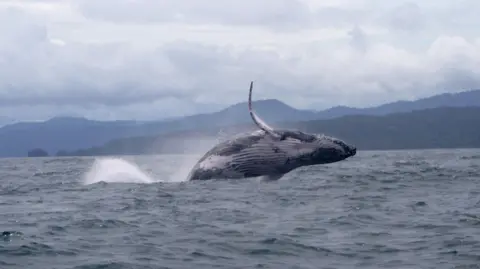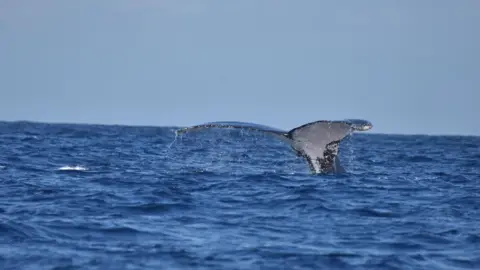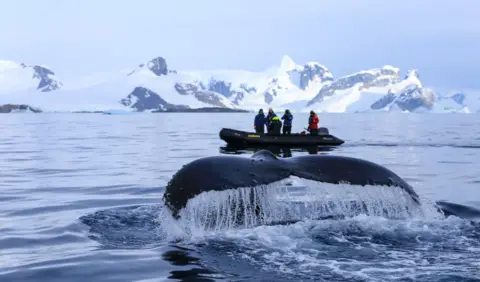 Natalia Botero-Acosta
Natalia Botero-AcostaA humpback whale has made one of the longest and most unusual migrations ever recorded, possibly driven by climate change, scientists say.
It was seen in the Pacific Ocean off Colombia in 2017, then popped up several years later near Zanzibar in the Indian Ocean – a distance of at least 13,000 km.
The experts think this epic journey might be down to climate change depleting food stocks or perhaps an odyssey to find a mate.
Ekaterina Kalashnikova of the Tanzania Cetaceans Program said the feat was “truly impressive and unusual even for this highly migratory species”.
The photograph below shows the same whale photographed in 2022, off the Zanzibar coast.
 Ekaterina Kalashnikova
Ekaterina KalashnikovaDr Kalashnikova said it was very likely the longest distance a humpback whale had ever been recorded travelling.
Humpback whales live in all oceans around the world. They travel long distances every year and have one of the longest migrations of any mammal, swimming from tropical breeding grounds to feeding grounds in cooler waters.
But this male’s journey was even more spectacular, involving two distant breeding grounds.
One theory is that climate change is altering the abundance of the tiny shrimplike krill humpback whales feed on, forcing them to travel further in search of food.
Alternatively, whales may be exploring new breeding grounds as populations rebound through global conservation efforts.
“While actual reasons are unknown, amongst the drivers there might be global changes in the climate, extreme environmental events (that are more frequent nowadays), and evolutionary mechanisms of the species,” said Dr Kalashnikova.
 BBC/Victoria Gill
BBC/Victoria GillThe wandering male was among a group of humpbacks photographed from a research vessel on the Pacific coast of Colombia in 2013.
He was then identified in a similar area in 2017 – and off Zanzibar in 2022.
The sightings are separated by a 13,046 km great-circle distance – the minimum distance for the route the whale might have taken, the scientists say, though it is likely to be much greater.
Since the earth is a sphere, the shortest path between two points is expressed by the great circle distance, which corresponds to an arc linking two points on a sphere.
The paperʻs findings are based on hundreds of thousands of photos of whales submitted by researchers, whale watchers and members of the public to the citizen science website, happywhale.com.
The database uses artificial intelligence to match the individual shapes and patterns of humpback whale tails, or flukes, thereby mapping their movements around the globe.
The research is published in the journal, Royal Society Open Science.
Find out more about humpback whales in The Secret’s of Antarctica’s Giants on BBC iPlayer.










